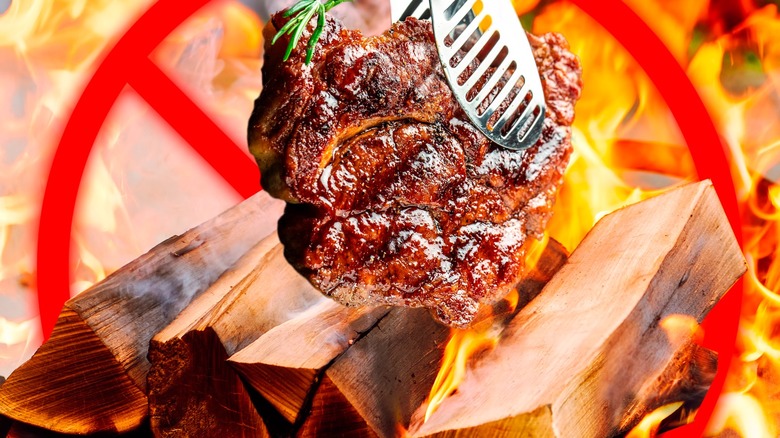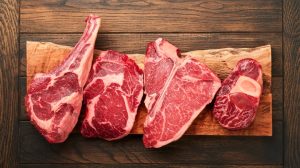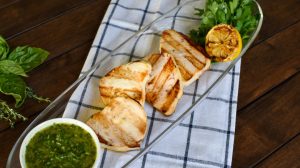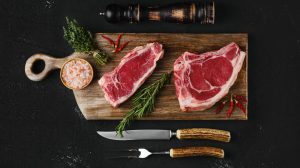Static Media / Shutterstock
There’s nothing better than biting into perfectly cooked juicy meat, especially when it’s been imbued with the subtle aroma of the wood it was smoked over. After all, there’s a reason all those Texas-inspired mesquite-flavored barbecue cuts fill up menus.
However, beginner grillers and smokers may not know that there are certain types of wood you should never use to cook meat, whether it’s because they will negatively affect the taste of the cut, or are actually toxic to humans. While avoiding some groups of wood may seem obvious — take wood containing toxins or chemically treated boards, for example — you may be surprised to discover just how many naturally sourced woods, or logs derived from seemingly harmless places like orchards, fall into these categories.
Let’s take a look at the types of wood you should always skip when it comes to grilling and smoking, so you can get one step closer to becoming a master griller. This way, no matter what you’re cooking, whether it’s meat, vegetables, or seafood, you can make a delicious big meal without running the risk of ruining its flavor or, worse, making all of your dinner party guests sick.
Softwoods and coniferous woods
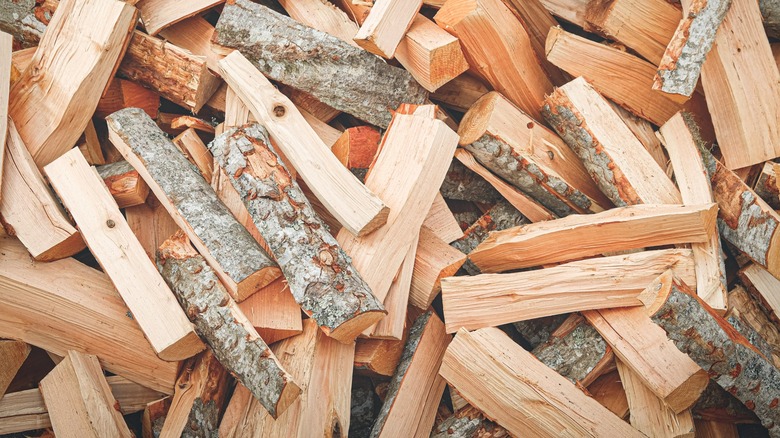
Softwoods are usually derived from coniferous trees, meaning they tend to have needles instead of typical leaves and stay green all year round as opposed to their deciduous cousins. As the name implies, the wood from these trees generally tends to be on the softer side, though there are exceptions. They also burn up relatively fast. This isn’t conducive to the long, slow, consistent burn required for a good smoking or grilling session, as cooking meat, vegetables, or whatever your dish of choice is over a grill or smoker usually requires more time.
In addition, the resin within a lot of these less dense woods can impart an astringent flavor to the meat that generally tastes awful, and can even make some people sick depending on the species. A lot of softwoods also have terpenes in their resin, which are compounds found in the oils of conifers and citrus trees. Scientists believe that terpenes protect plants from pathogens and other stressors, but they usually have a bitter, sometimes earthy taste that does nothing for a meal’s flavor profile.
Specifically, softwoods include species like pine, redwood, fir, cypress, spruce, and cedar. The last variety may be surprising to you since cedar plank-baked salmon is a popular (and delicious) dish, but baking salmon on a cedar plank and burning that plank for wood are two entirely different processes.
Moldy wood
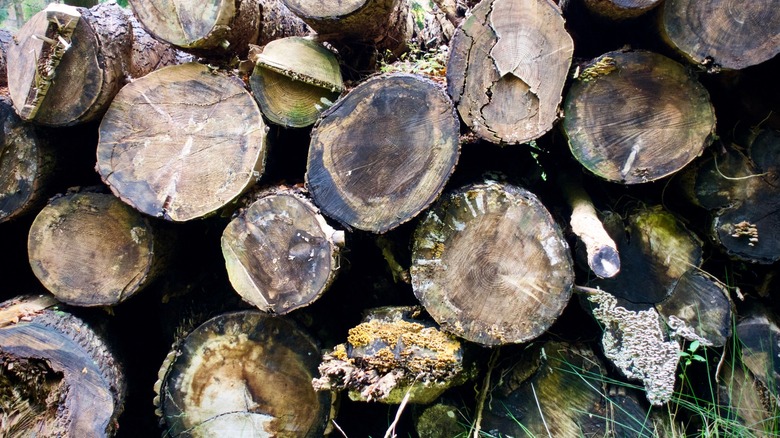
Most people don’t find themselves grilling, smoking, or burning firewood in a nice, cozy fireplace that often, meaning that a lot of people have old wood lying around their yards and homes that hasn’t been touched in months or years. You may be tempted to use this old wood for your next outdoor grilling session as a means of finally getting rid of it, but check it thoroughly before you start cooking, as moldy wood can negatively impact your health.
You may think a little green moss or mildew on wood is perfectly safe, especially if you live in a humid or rainy climate, but a lot of fungi contain toxins known as mycotoxins. These can cause serious issues if they are released into your meal, which they likely will be because they easily survive the burning process. What’s worse, they are also attracted to moisture — like the surface of a nice, juicy cooking steak.
Even if you don’t eat the mold-grilled meat, just being around the fumes from this wood can cause coughing, eye and throat irritation, and other respiratory problems — all side effects that will be even worse for those suffering from asthma. Not all fungus species contain mycotoxins that are dangerous to humans, but unless you are a skilled fungus expert, you probably won’t be able to tell safe and toxic varieties of mold and fungus apart. We recommend not even trying, and chucking that moldy wood out immediately.
Green or fresh wood
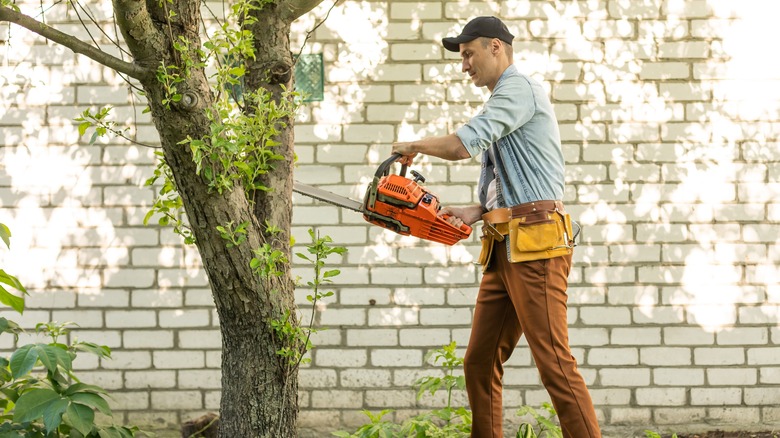
Andrew Angelov/Shutterstock
While it might be tempting to cut down a tree and use the wood right then, this isn’t actually a good idea for grilling. Why is fresh wood a problem? Freshly cut, or “green” wood, is still full of water, resulting in pungent, foul-smelling smoke that will impart a bitter taste to smoked meat. If you have ever tried to start a fire using fresh wood, you also know how hard it is to keep this kind of material burning for any length of time. It will just make the grilling or smoking process very long and frustrating — and likely unsuccessful — resulting in an imperfectly cooked meal.
It’s better to leave fresh wood out in order to season it and decrease its moisture content. Freshly cut wood may have a moisture content of between 60% and 120%, meaning there’s a chance you will find more water in your logs than actual wood. In order to burn slowly and efficiently, wood should have a moisture content of 40% or below, and many grillers prefer very dry wood with only around 20% moisture.
The seasoning process can take anywhere between six months and two years, and, in order for it to work well, you have to chop up, stack, and store your wood carefully (assuming you are doing the seasoning yourself). To do this, first cut up the wood into even pieces, then place it on a surface above the ground to prevent mold growth. Make sure you leave enough space between the pieces to allow air to flow through and thoroughly dry the wood.
Wood with toxins
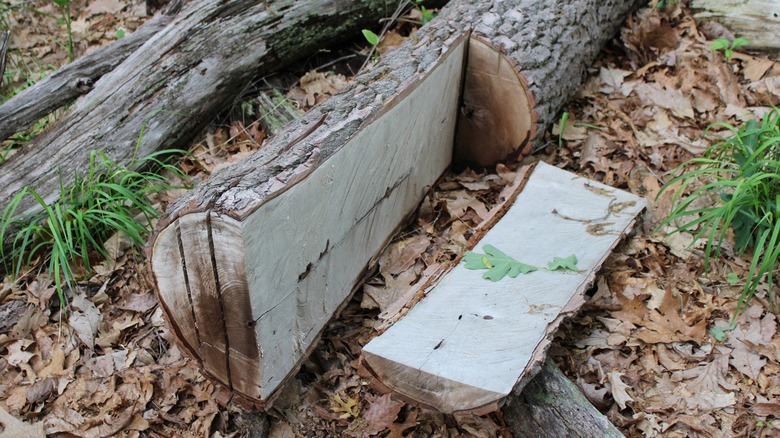
Sarah Macor/Shutterstock
This may seem like a no-brainer, as no one would want to deliberately use wood that contains toxins to cook a meal. However, do you know just how many naturally occurring woods fall into this category? Plenty of tree species, including some hardwoods you may think are alright to use for grilling, contain toxins, including oleander, sassafras, laburnum, black walnut, tambootie, yew, and mangrove wood.
Sassafras may be particularly surprising for some due to the popularity of sassafras tea, though, in modern days, most people who brew the tea extract the toxic oil, called safrole, from sassafras first. Safrole was found to be so problematic that the FDA banned it for human consumption in 1960 (which actually caused the formula for root beer to change in the U.S.). Though some wood smokers say it’s fine to use sassafras wood (pictured) in small quantities, we recommend avoiding it altogether. Besides its toxic properties, which can cause effects like coughing, sneezing, rashes, and other general irritation, the compound has also been found to be carcinogenic, per WebMD.
Wood-borne toxins can leech into the meat through the smoke of the grill and make you sick. In fact, you don’t even need to eat the resulting meal in order to suffer some of the side effects. Simply burning the wood will release a lot of the toxins contained inside it into the air, affecting both the cook and whoever happens to be standing near the grill.
Lumber and plywood
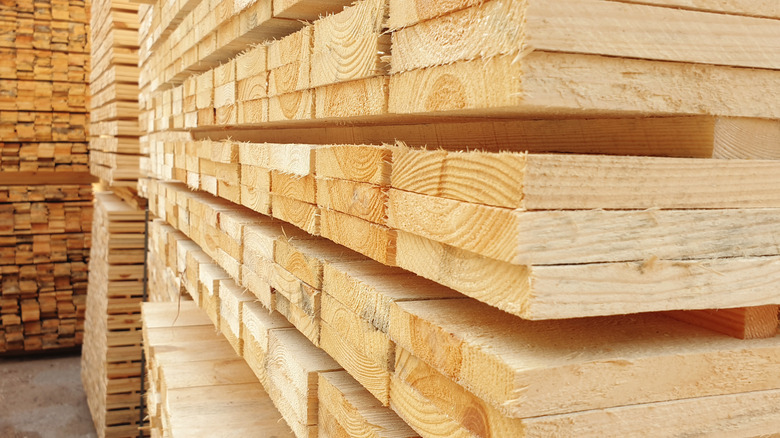
Alex Ander/Shutterstock
Plywood consists of multiple sheets of wood tightly bound together with an adhesive. This glue is usually a waterproof phenol formaldehyde resin adhesive, and most people don’t want a substance like that burning right into their Sunday steak. Even if you don’t get immediately sick, the Centers for Disease Control and Prevention notes that these materials can cause dermatitis and may even be carcinogenic, meaning frequently burning them could negatively affect your long-term health.
The problem with lumber is that it consists of assorted wood that you can’t really identify anymore, as it has been cut uniformly, packed together, and shipped out from its original source. That means that it could contain any of the woods you want to avoid, including toxic woods or softwoods. For all these reasons, it’s generally not even recommended to use lumber and plywood in a fire pit or fireplace, nevermind to help get a grill started. On top of that, lumber is often chemically treated or infused with pesticides in order to make it last longer and prevent rot or insect infestation.
Chemically treated wood
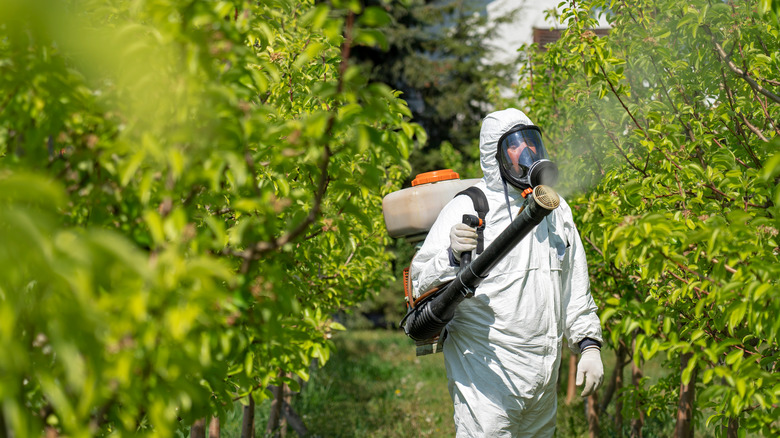
RGtimeline/Shutterstock
It may seem obvious to leave chemically treated wood off the grill, but a lot of wood you may not think falls into this category absolutely does. For example, if you decide to use woods sourced from old orchards, farming groves, or other types of land used primarily to grow fruits and flowers, the logs you get will likely have been treated with pesticides, insecticides, or a whole lot of other chemicals by the farmers who cultivate the trees.
You may think sourcing wood from an organic farm would avoid this issue, as federal regulations prevent the use of a lot of dangerous pesticides on organic farms. However, that’s not the case, as organic farming allows for a fair amount of chemicals to be used on trees as long as they are naturally occurring in some way.
Another type of wood that may be chemically treated includes wood pallets and any remaining wooden components tossed out by furniture manufacturers, who frequently treat the wood they use. Just as the spice or flavor of wood will be imparted into the meat you are grilling, the remnants of pesticides and chemicals on the surface of the wood may also soak into your meal.
Painted or stained wood
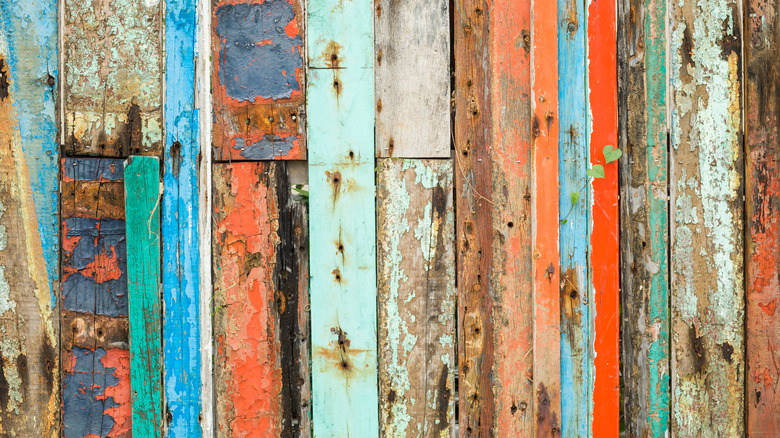
Phurinee Chinakathum/Shutterstock
For obvious reasons, woods painted or stained with anything chemical — or, really, anything at all — are not optimal for smoking or grilling, as the materials included in the paints and stains may be toxic. This is an important consideration for modern grillers, as people are becoming increasingly cognizant of environmental issues and are therefore more likely to recycle and reuse old materials they find lying around.
While this is an admirable goal, taking wood from old fences or broken-down buildings around you may pose a whole host of health issues if you use that wood to grill or smoke food. Even if the wood isn’t obviously painted, a lot of wood used in outdoor decor, landscape timbers, and fence posts has been treated in order to prevent rotting or insect infestation.
These treatments employ chemicals such as copper azole, which may be relatively safe for use in indoor furniture and walls but should by no means be transferred onto food via burning. In order to avoid painted and treated woods, you may want to steer clear of lumber scraps and wood that you might find in old pallets as well.
Eastern red cedar wood
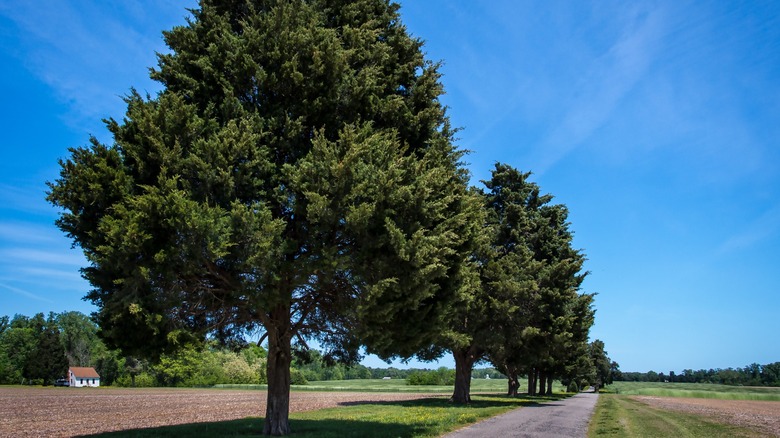
Gerry Bishop/Shutterstock
Due to the popularity of barbecuing and grilling with wood planks, especially for dishes like salmon, we thought this was a softwood we had to specifically mention, as it should probably be avoided due to possible hazardous effects. Eastern red cedar, scientifically known as Juniperus virginiana, is one of the most commonly found trees in the eastern United States. Owing to the strength of its wood,many people assume it’s a hardwood that can be used for grilling, even though it’s actually a softwood.
However, that’s far from the biggest issue when it comes to using eastern red cedar to smoke a dish. Burning wood to grill or smoke food will result in the substances present in that wood transferring onto the food. Sites like WebMD warn that this species is possibly unsafe if it is ingested in large amounts, and there have been reports of people experiencing burning in the stomach and vomiting after consuming large volumes of eastern red cedar essential oil.
Though not enough wide-scale studies have been done on the ingestion of eastern red cedar oil or smoke in small amounts, doctors still generally recommend avoiding it if possible. Since this species is most commonly found in the eastern U.S., learn to identify it if you live in the area, and make sure you don’t go around chopping down just any old tree for grilling.



